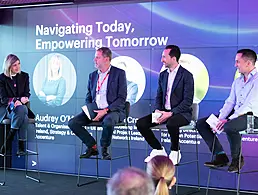Careers guru and businessperson Marc Cenedella gives his top tips on CV writing for people who want to nab themselves a high-paying STEM job.
People who want hefty pay packets are often directed towards STEM roles and for good reason. The highest-paying careers out there are at the cutting edge of science and technology. For example, last year a survey by Revolent and Mason Frank International found that the average salary for an Irish cloud professional was $75,547 per year. It’s significantly higher in the US at $114,772, but the highest of all is in Switzerland at $133,326.
A more recent example of the high salaries sci-tech workers can expect to receive is the $900,000 per year net salary attached to the role of AI product manager at Netflix. The job posting’s rather generous salary raised a few eyebrows with Tech Crunch writing that it was hypocritical to offer such an amount for one role when Netflix’s writers and actors are currently striking over low pay.
Of course, whether you’re competing for a role that offers nearly $1m or one with a more modest pay packet, what counts is that you really enjoy the work. Most STEM roles are fairly competitive so it’s always a good plan to aim for your application to stand out and be as polished as possible.
We asked careers guru Marc Cenedella for some advice on how to secure your dream high-paid role in STEM. “When it comes to high-paying prompt engineer and other AI-prompting related jobs, we’re in the midst of a revolution,” he said. “No one is truly an expert yet, which means you are starting at the same time as everyone else who will be an expert. It’s a gold rush opportunity.”
Believe in yourself or nobody else will
For these relatively new roles like AI prompt engineer, Cenedella pointed out that it doesn’t matter if you don’t meet every requirement in the job description. Just go for it, he added. “Recruiters aren’t going to take a chance on you if you don’t take a chance on yourself.”
If you really want to be paid big bucks for one of these emerging tech roles, focus on “building true expertise” – although this will be a work in progress. “Demonstrate you have curiosity, capacity and capability to thrive in the field by putting in the time and effort to learn as much as you can. Read papers on Large Language Models (LLMs), join online forums with other learners, get your hands dirty and play in online tool sandboxes.”
Show your enthusiasm
The most important qualities to demonstrate to recruiters are enthusiasm and a desire to learn. Explain what you’re doing to learn about the field and to build your skillset. Something like, “Since ChatGPT was released last November, I’ve spent more than 100 hours delving into its features. I’m a member of several online learning groups and have been studying APIs.”
Cenedella has reviewed thousands of cover letters as part of his career and he has found that “positivity and enthusiasm can make up for some experience”. As well as writing several books about jobs, Cenedella runs his own businesses Leet Resumes and The Ladders. The latter is a careers site, while Leet Resumes is an AI-powered résumé-writing tool that helps jobseekers fine-tune their applications.
With some jobseekers tempted to leverage the convenience of AI to help land a job, Cenedella has some sound advice on how not to use AI. He cautioned against using “generic” tools like ChatGPT for résumé writing. Certainly, it is best to avoid ChatGPT and others for things like fact-checking as it often makes mistakes. It’s also best to try and write your CV and cover letter in your own words where possible. This is the key to making it sound genuine and unique. No recruiter wants to read a résumé written by a machine. As Cenedella said, let your passion shine through.
Forget fancy formatting
He also has a few tips for applicants on tailoring their applications based on the (very probable) assumption that recruiters use AI software to filter through candidates. There are certain things – such as formatting – that AI doesn’t pick up when it is scanning résumés, which is something to consider when writing yours.
“AI-based Applicant Tracking Systems (ATS), and ATSs in general, don’t recognise fancy formatting. Use a simple, standard one-column layout with a basic font. Don’t use photos or graphics,” said Cenedella. He is not a fan of “dressing up your CV like it’s going to Cinderella’s ball”.
“These systems can also struggle with translating hyperlinks within sentences. If you must include a link, it’s a good practice to include it at the end of a sentence rather than in the middle of a sentence.
“You want your CV to be clean, simple and easy for digital Applicant Tracking Systems to scan. These readers scramble superfluous design elements so even if you’re the best applicant, a real human may never get to read your CV.”
Don’t be afraid to think outside the box
Instead of fancy formatting, use your words to convey your accomplishments. “Employers won’t count you in if you can’t count your accomplishments,” Cenedella pointed out, adding that not doing so is a “sure way to land in job search purgatory”.
“That means instead of listing responsibilities like, ‘Analysed user data and wrote marketing plans,’ write, ‘Increased site visits 45pc by analysing user data and using that data to create and implement a new social media marketing initiative’.”
Another tip of Cenedella’s is not to forget about your life beyond your career when applying for a job. For example, if you’re struggling to think of a time when you showed leadership, don’t forget that does not necessarily have to be in your last job. It can be from a time you led a sports team or chaired an initiative as a non-profit volunteer. “In your cover letter, highlight concrete examples of where you’ve shown leadership skills in your life. Remember to quantify your stories,” said Cenedella.
10 things you need to know direct to your inbox every weekday. Sign up for the Daily Brief, Silicon Republic’s digest of essential sci-tech news.




